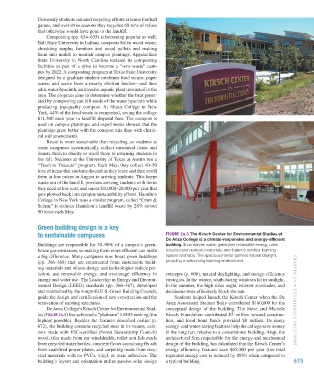Page 676 - Environment: The Science Behind the Stories
P. 676
University students initiated recycling efforts at home football
games, and over three seasons they recycled 68 tons of refuse
that otherwise would have gone to the landfill.
Composting (pp. 634–635) is becoming popular as well.
Ball State University in Indiana composts bulky wood waste,
shredding surplus furniture and wood pallets and making
them into mulch to nourish campus plantings. Appalachian
State University in North Carolina updated its composting
facilities as part of a drive to become a “zero waste” cam-
pus by 2022. A composting program at Texas State University
designed by a graduate student combines food scraps, paper
waste, and waste from a nearby chicken feedlot—and then
adds water hyacinth, an invasive aquatic plant unwanted in the
area. The program aims to determine whether the heat gener-
ated by composting can kill seeds of the water hyacinth while
producing top-quality compost. At Ithaca College in New
York, 44% of the food waste is composted, saving the college
$11,500 each year in landfill disposal fees. The compost is
used on campus plantings, and experiments showed that the
plantings grew better with the compost mix than with chemi-
cal soil amendments.
Reuse is more sustainable than recycling, so students at
some campuses systematically collect unwanted items and
donate them to charity or resell them to returning students in
the fall. Students at the University of Texas at Austin run a
“Trash to Treasure” program. Each May, they collect 40–50
tons of items that students discard as they leave and then resell
them at low prices in August to arriving students. This keeps
waste out of the landfill, provides arriving students with items
they need at low cost, and raises $10,000–20,000 per year that
gets plowed back into campus sustainability efforts. Hamilton
College in New York runs a similar program, called “Cram &
Scram.” It reduces Hamilton’s landfill waste by 28% (about
90 tons) each May.
Green building design is a key
to sustainable campuses Figure 24.5 The Kirsch Center for Environmental Studies at
De Anza College is a climate-responsive and energy-efficient
Buildings are responsible for 70–90% of a campus’s green- building. It conserves water, generates renewable energy, uses
house gas emissions, so making them more efficient can make recycled and nontoxic materials, and features outdoor learning
a big difference. Many campuses now boast green buildings spaces and labs. The spacious interior gathers natural daylight,
(pp. 366–368) that are constructed from sustainable build- providing a welcoming learning environment.
ing materials and whose design and technologies reduce pol-
lution, use renewable energy, and encourage efficiency in concepts (p. 606), natural daylighting, and energy-efficiency
energy and water use. The Leadership in Energy and Environ- strategies. In the winter, south-facing windows let in sunlight.
mental Design (LEED) standards (pp. 366–367), developed In the summer, the high solar angle, exterior sunshades, and
and maintained by the nonprofit U.S. Green Building Council, deciduous trees effectively block the sun.
guide the design and certification of new construction and the Students helped launch the Kirsch Center when the De
renovation of existing structures. Anza Associated Student Body contributed $180,000 for the CHAPTER 24 • Su STA in A bl E Sol u T i on S
De Anza College’s Kirsch Center for Environmental Stud- conceptual design of the building. The Steve and Michele
ies (Figure 24.5) has achieved a “platinum” LEED ranking (the Kirsch Foundation contributed $2 million toward construc-
highest possible). Besides the features described earlier (p. tion, and local bond funds provided $8 million. Its many
672), the building contains recycled steel in its beams, cabi- energy- and water-saving features help the college save money
nets made with FSC-certified (Forest Stewardship Council) in the long run, relative to a conventional building. Arup, the
wood, tiles made from car windshields, toilet seat lids made architectural firm responsible for the energy and mechanical
from recycled water bottles, concrete floors containing fly ash design of the building, has calculated that the Kirsch Center’s
from coal-fired power plants, and carpeting made from recy- energy efficiency features save $65,000 per year (the total
cled materials with no PVCs, vinyl, or toxic adhesives. The regulated energy cost is reduced by 88%) when compared to
building’s layout and orientation utilize passive solar design a typical building. 675
M24_WITH7428_05_SE_C24.indd 675 13/12/14 10:40 AM

